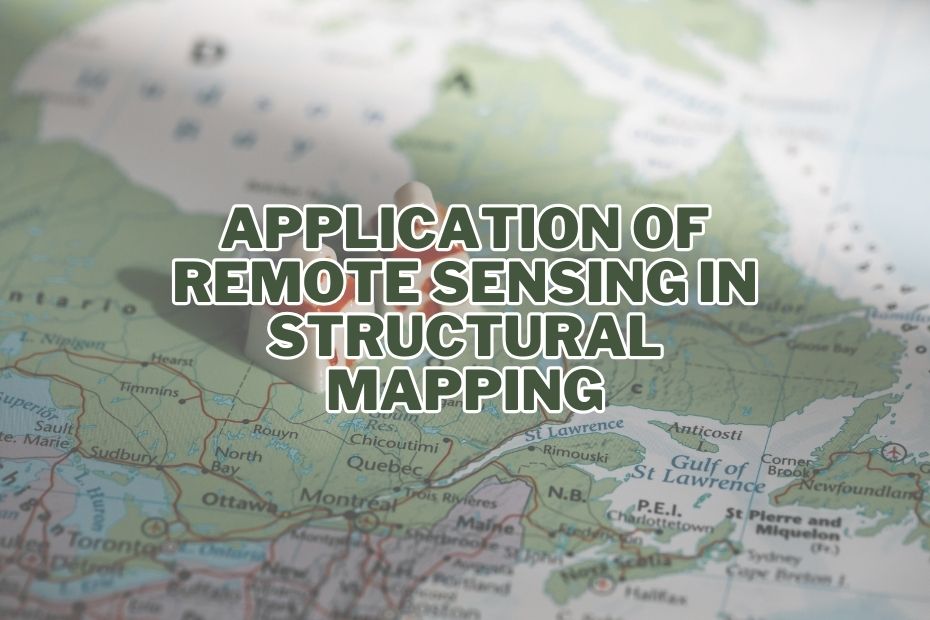Remote sensing, a cutting-edge technology, has emerged as a game-changer in various fields. Its applications are diverse and impactful, with one of its most crucial roles being structural mapping. In this article, we will delve into the various application of remote sensing in structural mapping, exploring how this technology revolutionizes our understanding of the Earth’s surface.
Remote sensing plays a crucial role in structural mapping by providing data that helps create accurate maps and models of physical structures.
Application of Remote Sensing In Structural Mapping
Remote sensing is a powerful technology that enables us to collect data about the Earth’s surface from a distance. It has a wide range of applications, including structural mapping.
1. Urban Planning and Development
Urban areas are ever-evolving, and effective planning is vital for sustainable growth. Remote sensing offers a bird’s-eye view of cities, providing valuable data on land use, population density, and infrastructure. This data helps urban planners make informed decisions, leading to efficient resource allocation and improved quality of life for residents.
2. Environmental Monitoring
Protecting our environment is a global priority. Remote sensing aids in monitoring natural resources, air and water quality, and biodiversity. It enables the timely detection of environmental changes, helping authorities take corrective measures and mitigate the impact of pollution and climate change.
3. Disaster Management
In times of disaster, every second counts. Remote sensing assists in disaster preparedness and response by providing real-time data on natural disasters like cyclones, earthquakes, and floods. This information aids emergency services in planning evacuations, assessing damage, and coordinating relief efforts effectively.
4. Agriculture and Crop Management
Precision agriculture is revolutionizing farming. Remote sensing provides farmers with vital information on soil health, crop health, and moisture levels. This data allows for precise application of fertilizers and pesticides, reducing waste and increasing crop yields.
5. Archaeological Exploration
Unlocking the mysteries of the past requires careful examination of historical sites. Remote sensing, including LiDAR technology, has enabled archaeologists to uncover hidden structures and landscapes buried beneath the earth’s surface. This has led to remarkable discoveries, enhancing our knowledge of ancient civilizations.
6. Geological Surveys
Understanding the Earth’s geological makeup is crucial for resource management. Remote sensing aids in geological surveys by mapping mineral deposits, identifying fault lines, and assessing volcanic activity. This information informs sustainable mining practices and disaster preparedness.
7. Transportation and Infrastructure
Efficient transportation networks are the lifeblood of economies. Remote sensing plays a vital role in infrastructure planning and maintenance by monitoring roads, bridges, and railways for signs of wear and tear. This proactive approach ensures public safety and reduces maintenance costs.
8. Forestry Management
Sustainable forestry practices are vital for preserving our ecosystems. Remote sensing helps in monitoring forest health, detecting illegal logging, and assessing the impact of wildfires. This technology is pivotal in ensuring that our forests thrive for generations to come.
9. Water Resources Management
Water scarcity is a growing concern. Remote sensing aids in monitoring water bodies, measuring water levels, and assessing water quality. This data is indispensable for managing water resources efficiently and ensuring a sustainable supply of clean water.
10. Land Use Classification
Accurate land use information is essential for urban planning, agriculture, and conservation efforts. Remote sensing provides detailed land cover and land use classifications, helping decision-makers allocate resources effectively and protect natural habitats.
11. Military and Defense
National security relies on up-to-date intelligence. Remote sensing supports military and defense agencies by providing high-resolution imagery for reconnaissance, border surveillance, and disaster response. Its use in defense technology is invaluable for safeguarding nations.
12. Climate Change Research
Understanding climate change is vital for mitigating its effects. Remote sensing instruments collect data on temperature, greenhouse gas emissions, and ice melt. This information is crucial for climate scientists and policymakers in developing strategies to combat global warming.
13. Wildlife Conservation
Preserving biodiversity is a global imperative. Remote sensing aids in wildlife conservation by tracking animal migration, monitoring habitat changes, and identifying poaching activities. This technology empowers conservationists to protect endangered species and their habitats.
Conclusion:
In conclusion, remote sensing has revolutionized structural mapping across various sectors, from urban planning to wildlife conservation. Its ability to provide accurate, real-time data has transformed decision-making processes and improved resource management. As technology continues to advance, we can expect even more exciting applications of remote sensing in the future.
FAQs: Application of Remote Sensing In Structural Mapping
What are the advantages of using remote sensing in structural mapping?
The advantages of remote sensing include its ability to provide large-scale, up-to-date information, cost-effectiveness, and the ability to access remote or hazardous areas. It also allows for non-invasive data collection.
How does remote sensing benefit urban development?
It allows urban planners to visualize cityscapes, track urban growth, and plan sustainable infrastructure developments.
Can remote sensing predict natural disasters?
Yes, remote sensing can track impending cyclones, monitor flood-prone zones, and even predict volcanic eruptions.
How does remote sensing aid wildlife conservation?
It assists in mapping habitats, tracking animal movements, and evaluating threats to endangered species.
